10 Top Tourist Attractions in Laos
Laos is a mountainous and landlocked country in South-East Asia that has long been isolated from the outside world. A visit to Laos is, in many ways, a trip back in time. Travelers are drawn here by a laid-back lifestyle that has disappeared elsewhere in the region. Even the capital Vientiane feels like a relaxed riverfront town. As the country opens up, with an increasing number of roads and bridges being built the amazing tourist attractions in Laos are becoming more and more accessible.
10Vieng Xai
 flickr/Peter Garnhum
flickr/Peter Garnhum
The Vieng Xai caves are an extensive network of caves that served as hidden city during the Vietnam War. The area was home to the Communist army, who were fighting the royalist forces based in Vientiane and was bombed by the US army. Up to 23,000 people lived in the caves, which contained a hospital, military barracks, bakeries, shops, and even a theater. The Lao government hopes to promote the caves as a tourism destination, similar to the Củ Chi tunnels in Vietnam.
9Pak Ou Caves
 flickr/Egui_
flickr/Egui_
The Pak Ou Caves are located north of Luang Prabang on the Mekong river and can be reached by road or river boat. The caves are famous for their miniature Buddha sculptures. Hundreds of very small and mostly damaged wooden Buddhist figures are laid out over the wall shelves. They take many different arrangements, including meditation, teaching, peace, rain, and reclining (nirvana).
8Wat Phu
 flickr/prezius
flickr/prezius
Wat Phu (or Vat Phou) is a ruined Khmer temple complex located at the base of mount Phu Kao, in the Champasak province. The Hindu temple structures date from the 11th to 13th centuries. Wat Phu is small compared with the monumental Angkor-era sites in Cambodia but the tumbledown pavilions, enigmatic crocodile stone and tall trees that shroud much of the site give Wat Phu a mystical atmosphere. The temple is still in use as a Buddhist site today.
7Pha That Luang
 flickr/A_E_P
flickr/A_E_P
Located in Vientiane, Pha That Luang (“Great Stupa in Lao”) is one of the most significant monument in Laos. The stupa has several terraces with each level representing a different stage of Buddhist enlightenment. The lowest level represents the material world; the highest level represents the world of nothingness. Pha That Luang was built in the 16th century on the ruins of an earlier Khmer temple. Pha That Luang was smashed by a Siamese invasion in 1828, then later reconstructed by the French in 1931.
6Wat Xieng Thong
 flickr/Hanoi Mark
flickr/Hanoi Mark
Located near the northern tip of the peninsula formed by the Mekong and the Nam Khan rivers, Wat Xieng Thong is Luang Prabang’s most magnificent temple. It was built in 1560 by King Setthathirath and was under royal patronage during the Kingdom of Laos. Wat Xieng Thong contains a rare reclining Buddha statue that dates from the construction of the temple. In 1931, the image was taken to Paris and displayed at the Paris Exhibition, only to return to Luang Phrabang more than 30 years later.
5Plain of Jars
 flickr/joaquinuy
flickr/joaquinuy
The Plain of Jars is a large area extending around the town of Phonsavan, where huge jars of unknown origin are scattered around the landscape. The stone jars appear in clusters, ranging from a single or a few to several hundred jars. The jars vary in height and diameter between 1 and 3 meters and are all hewn out of rock. The stone jars are undecorated with the exception of a single jar that has a human bas-relief carved on the exterior. Research of the Plain of Jars suggests that the stone jars are associated with prehistoric burial practices.
4Si Phan Don
 flickr/ScruffyDan and Breanne
flickr/ScruffyDan and Breanne
Si Phan Don (meaning 4,000 islands) is a beautiful set of islands, set against a scenic section of the Mekong River in Southern Laos. The Mekong is impassable to river traffic here due to the Khone Falls, a series of rapids that stretch 9.7 km (6.0 miles) of the river’s length. The Mekong below the falls has a small population of the highly endangered Irrawaddy Dolphins. The three principal islands that cater to tourists are Don Det, Don Khon and Done Kong. Most of the lodging available on Don Det and Don Khon consists of simple, family run bungalows. Bikes and kayaks can also be rented here.
3Vang Vieng
 flickr/Prince Roy
flickr/Prince Roy
Vang Vieng is a riverside town, located in central Laos about a 4 hour bus ride north of the capital. The main street is full of guest houses, bars, restaurants, internet cafes, tour agencies, and tourists. The area’s main attraction is the dramatic karst hill landscape surrounding Vang Vieng. The limestone mountains are popular with rock climbers while the many unexplored tunnels and caverns are a spelunker’s heaven. Vang Vieng’s most popular activity however is simply floating along the Nam Song river in a inner tube.
2Mekong River
 flickr/Jody Art
flickr/Jody Art
The Mekong is Southeast Asia’s greatest river with an estimated length of 4,350 km (2,703 miles). Laos actually has the greatest share of the Mekong River. With few good roads and mountainous terrain, the river is Laos’ principal transportation. The Upper Mekong in Laos is considered one of the most stunning journeys of the entire river. A great way to enjoy the scenery is a boat trip from Huay Xai at the border with northern Thailand to Luang Prabang, or vice versa.
1Luang Prabang
 flickr/wharman
flickr/wharman
One of the most charming cities in south-east Asia, Luang Prabang is the most popular tourist attraction in Laos. Until 1975, when the communist took over the country, it was the royal capital of Laos. The main part of Luang Prabang is located on a peninsula between the Nam Khan and Mekong rivers. A collection of golden-roofed temples, wooden houses and crumbling French provincial buildings fill the main roads. At dawn, monks from the various monasteries walk through the streets collecting alms of rice.


















